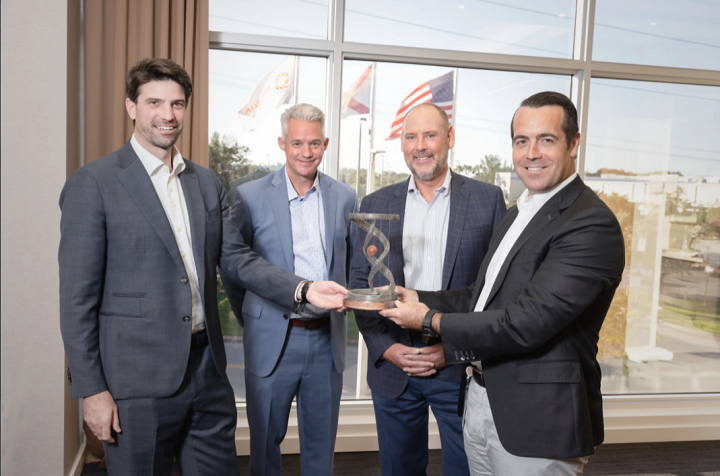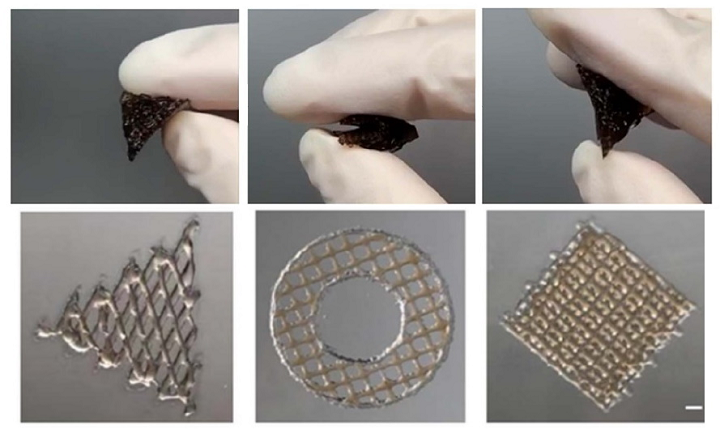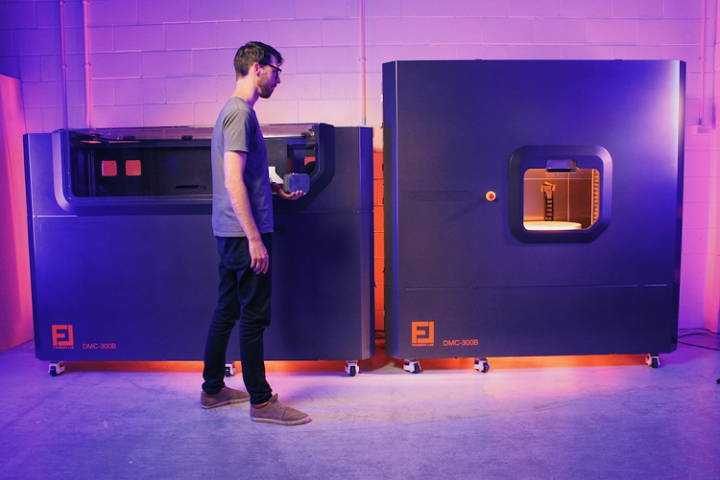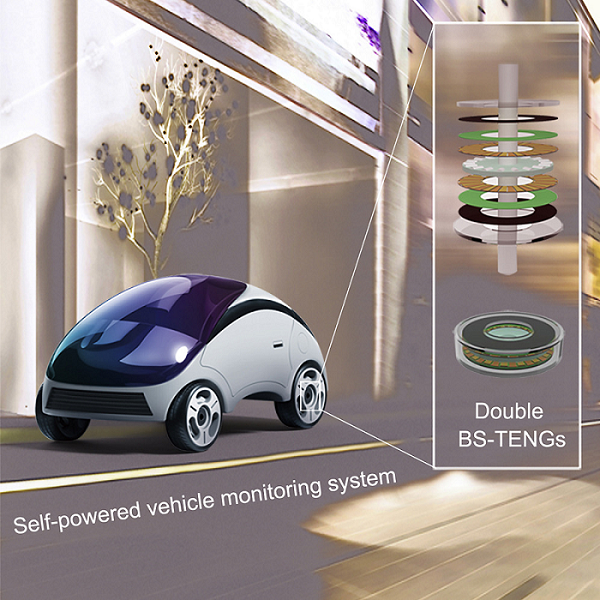We’ve got business to share in today’s 3D Printing News Briefs, as Freemelt and Etteplan have entered into a strategic partnership, EOS installed its 1,000th 3D printer in the North American market, and a digital metal casting startup raised $8 million in a funding round. Moving on to research, scientists in China are 3D printing triboelectric nanogenerators, or TENGs, for intelligent vehicle monitoring, while researchers in Australia are using 3D printing to grow skin. Finally, a maker attempted to build his own metal 3D printer, the results of which were pretty interesting.
Freemelt and Etteplan Join Strategic Partnership

L-R: Ulric Ljungblad, CEO of Freemelt, and Riku Riikonen, Senior Vice President, Engineering Solutions, Etteplan
First up, high-tech growth company Freemelt, which calls itself the “catalyst of the metal 3D printing world,” and engineering solutions provider Etteplan have entered into a strategic partnership for the purposes of jointly developing and industrializing Freemelt’s next metal 3D printer. Freemelt specializes in Electron Beam Powder Bed Fusion (E-PBF) technology, and plans for its next system to be tailormade for industrial purposes, with improved productivity, reliability, and robustness. The partnership, meant to deliver 3D printing capacity to manufacturers around the globe, will rely on Freemelt’s expertise in designing and building 3D printers, as well as Etteplan’s capabilities in engineering and software development.
“Etteplan has identified AM as one of the most important technologies for the future and we are committed to continue building our capabilities in AM,” said Riku Riikonen, Senior Vice President, Engineering Solutions, for Etteplan. “A close partnership with Freemelt opens up possibilities to deepen the knowledge in the area and creates synergies with the potential to substantially increase the value offered to the market and to our common customers over time.”
EOS Reaches Milestone with 1,000th Printer Delivery in North America

In recognition of EOS’ 1,000th machine installation in North America, EOS presented Sintavia with a 3D printed commemorative award.
EOS recently reached a major milestone with the delivery and installation of its 1,000th 3D printer in North America, specifically the large-scale AMCM M 4K system. The four-laser printer, which is capable of printing parts up to one meter high, was installed at metal AM manufacturer Sintavia, which has 16 other 3D printers from EOS and fabricates advanced propulsion systems for the aerospace, defense, and space industries. EOS, which has been in business for more than 30 years, presented Sintavia with a special award that was designed by EOS Additive Minds Engineer Jorge Cisneros and 3D printed on the EOS M 290 out of Ti64, 316L, and Cu pure copper to commemorate the milestone.
“This achievement is a significant milestone in the history of EOS and a testament to the accelerating adoption of additive manufacturing in North America. As the proliferation of AM continues, we remain the leading innovator of hardware, materials, services, and education aimed at strengthening the successful adoption and advancement of AM as a mainstream manufacturing process,” said Andrew Snow, Senior Vice President of EOS North America, as well as one of its longest tenured employees.
“When customers purchase from EOS, they are installing mature technology that leverages more than three decades of experience, as well as complete support for all of their AM requirements. While our industry looks vastly different than it did over 30 years ago, one thing has remained: EOS continues to serve as the industry leader, pushing industrial 3D printing in new, groundbreaking directions.”
Foundry Lab Emerges From Stealth with $8 Million in Series A
With more business news from the metal AM industry, New Zealand digital metal casting (DMC) startup Foundry Lab has come out of stealth with the announcement of an $8 million Series A funding round, led by Blackbird Ventures and joined by new investors GD1, Icehouse, and K1W1, with participation by existing investors Founders Fund, Promus, and WNT Ventures. The startup has developed microwave casting technology that can supposedly fabricate production-strength metal cast components from CAD files in less than eight hours. If the startup can do what it says it can, this could enable same-day turnaround and potentially make mass manufacturing industries not yet touched by metal AM very happy, as parts made with current casting systems like die casting and investment casting can take anywhere from one to six weeks minimum. Foundry Lab will use the funding to scale its team with new roles in software engineering, RF/microwave engineering, mechatronics, and more.
Foundry Lab CEO and founder David Moodie, a former industrial designer, said, “3D printing is great for look-alike parts, but the world runs on real parts, and metal printing can never produce a real casting. I soon discovered that a foundry just doesn’t fit in an R&D lab, so instead the approach became how can an R&D team make metal castings in-house without becoming a foundry?”
Intelligent Vehicle Monitoring with 3D Printed TENG
A triboelectric nanogenerator, or TENG, is an energy harvesting device, and according to research, self-powered TENG-based sensing technology has a lot of advantages over traditional power supply technology. A team of scientists from various universities and institutes in China and the US have been developing a 3D printed bearing structural-(BS) TENG to use for intelligent vehicle monitoring applications; it will act as both a rotational mechanical energy harvester and a self-powered sensor system under a high rotational speed. A good way to improve the output power of a TENG is maintaining its high working frequency, which is what the 3D printed BS-TENG should be able to help achieve. In fact, the researchers concluded that using the BS-TENG, made up of a 3D printed rotor and stator, could enable the accuracy of self-powered vehicle speed monitoring by more than 99%.
“Herein, we propose a bearing structural TENG (BS-TENG), which achieves a speed of nearly 1,500 rpm based on the diversified design of 3D printing. It is vital that a BS-TENG unit delivers a peak power of 0.96 mW under an external load of 8 MΩ and, in addition, charges a capacitor of 1,000 μF to reach a voltage of 4 V that takes merely 80 s at a rotational speed of 600 rpm. The integrated BS-TENG network serves as both an energy harvester and a self-powered high-speed sensing system for the safe operation of vehicles. This study presents an approach for upgrading the working frequency of TENGs and may provide new opportunities for TENGs in intelligent automobile driving systems.”
Australian Researchers 3D Printing Full-Thickness Skin

Flexible designs: The printed scaffolds were highly elastic and could recover after bending (top row); printed structures of various patterns (bottom row). (Courtesy: Y Zhou et al Biofabrication 10.1088/1758-5090/ac2ef8)
In order to repair injuries to the skin, which is made up seven tissue layers, scientists have been able to grow the epidermis in the lab, but full-thickness, functional skin containing blood vessels is another story. That’s why researchers at the Intelligent Polymer Research Institute (IPRI) at Australia’s University of Wollongong, driven by collaborators at St. Vincent’s Hospital in Melbourne and the Fiona Stanley Hospital and Western Australia Burns Service, have been using 3D printing to create a skin-like structure that can support the growth of dermal fibroblasts found in the skin’s inner layers. In a published study, the team presented a 3D printing platform for engineering functional, full-thickness skin tissue using a custom-designed ink composed of alginate and catechol-hyaluronic acid (HACA). This ink balances mechanical properties and cytocompatibility (doesn’t harm cells) with structural support, and the resulting 3D printed hydrogel skin scaffold—with gelatin microchannels mimicking blood vessels— is highly elastic and tough, and can recover after bending.
“There have been tremendous advances in biomaterials science and cell biology with respect to tissue engineering over the past two decades. Advances in 3D biofabrication enable us to converge knowledge in these two areas and to arrange existing materials in a way that dramatically enhances performance,” explained Gordon Wallace, director of the IPRI.
DIY Metal 3D Printer with MIG Welder
Finally, a maker named Lucas, who runs the Cranktown City YouTube channel featuring “escapades of messing around in the shop,” decided to try building his own metal 3D printer, which seems like a pretty tough project. As explained in a Hackaday post, his first attempt was basically adding a MIG welder onto a Creality Ender 3 system, which, as Hackaday blogger Dan Maloney explained, “in no way was ready for the abuse it was about to endure.” In fact, Lucas himself called it a “janky setup,” and he wasn’t entirely wrong when he bid adieu to his trusty Ender 3 at the start of his first video, figuring that the desktop printer wouldn’t make it through—that poor machine has definitely seen better days.
However, he did learn from his first blobby, melted prototype prints, and set about adding improvements to his setup, including a better build plate, built-in current control with a non-destructive interface to the welder controls, heat shielding for the printer itself, a stepper motor in place of a servo, and an actual MIG welder wire feeder, which can push the wire through much more easily than the original spool gun he was using. In his second video, Lucas attempted to print a Benchy boat, which took seven hours and actually started out pretty well, though it looked rather droopy at the end. But you can at least tell what it’s supposed to be, even if Lucas did dub his metal Benchy attempt the “most high effort paperweight ever.”
Subscribe to Our Email Newsletter
Stay up-to-date on all the latest news from the 3D printing industry and receive information and offers from third party vendors.
You May Also Like
3D Printing Financials: Prodways’ Q1 2024 Revenue Drop and Accounting Overhaul
Prodways (EPA: PWG) has released its earnings report for the first quarter of 2024, announcing modest revenue. This result is lower than last year’s, reflecting the company’s ongoing adjustments to...
3D Printing Financials: Prodways Faces Headwinds, Cuts Jewelry Printers and Cristal Dental Lab for Turnaround
Prodways (EPA: PWG), a European leader in industrial 3D printing, encountered financial challenges in 2023, as revealed in its earnings report. The company saw a decline in revenue and profitability...
Printing Money Episode 12: Q3 2023 Earnings Reports with Troy Jensen, Cantor Fitzgerald
Episode 12 of Printing Money brings with it a slightly different approach, as Alex Kingsbury sits this one out while Danny runs the show. Equity research analyst Troy Jensen, now of Cantor...
3D Printing News Briefs, November 18, 2023: Depowdering, Jewelry Patterns, & More
We’re kicking off 3D Printing News Briefs with a little business today, as Horizon Microtechnologies invested in a micro AM platform from Boston Micro Fabrication, and Rivelin Robotics announced a...
































